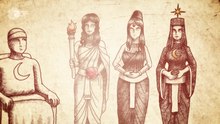al-ʿUzzā
Al-'Uzzā ( Arabic العزى, DMG al-ʿUzzā 'the most powerful'; etymologically related to " Aziz ", from Arabic عزیز, DMG ʿazīz 'mighty, dear, dear') was the ancient Arabic goddess of the morning star Venus . In pre-Islamic times, she was one of the three main deities worshiped in Mecca alongside al-Lāt and al-Manat . Her seat was assumed in a red stone and votive gifts and sacrifices were offered to her on pilgrimages. Mohammed fought against the cult of the goddess as unbelief and had the sanctuary of al-Uzza, in which according to some traditions also an oracle was located, destroyed by his general Chālid ibn al-Walīd , after the conquest of Mecca.
Lore
al-Uzza is mentioned in the Koran , sura 53 , verses 19 to 23 and 27, 28 next to al-Lāt and al-Manat:
“(19) Have you seen al-Lat and al-Uzza,
(20) and also al-Manat, this other one, the third?
(21) Is what is masculine for you and what is feminine for Him?
(22) That would then be an unjust distribution.
[…] Those are just empty names that you and your fathers thought up for idols, for which Allah has not given permission. "
One tradition (mostly with weak chains of narration ) claims that initially because of a kind of devilish whispering ( Satanic verses ) during the prophet's lecture it was temporarily said:
“(19) Have you seen al-Lat and al-Uzza,
(20) and also al-Manat, this other one, the third?
(21) These are the sublime cranes.
(22) One can hope for her intercession. "
In the book of idols of Ibn al-Kalbī it says about al-'Uzzā:
“She is younger than al-Lāt and Manāt. […] The Arabs and the Quraish named (their children) by the names' Abd al-'Uzzā. She was the highest idol among the Quraish. They used to visit her, bring her presents and make sacrifices at her place. We heard that the Messenger of God (God bless him and give him salvation) mentioned it one day; he said: 'I offered a reddish white sheep to al-'Uzzā at the time when I was still professing my people's cults'. The Quraish used to orbit the Kaaba saying: “By al-Lāt and by al-'Uzzā and by Manāt, the third, the other! They are the very highest swans and one can hope for their intercession (with God) ”. The Quraish had created a himā for her, in a mountain canyon of Wadi Hurād, called Suqām. They created a side piece to the Haram, the holy precinct of the Kaaba ... al-'Uzzā had a slaughtering site where their victims were slaughtered; his name was al-Ghabghab. "
Others
It has not yet been scientifically clarified when these three old goddesses were reinterpreted as daughters of the High God, Allah . According to some, the traditions of the above-mentioned Quranic verses from Sura 53 show that Muhammad initially tried to include these goddesses, which were very popular with the ancient Arabs (see also Satanic Verses ). In the year of the conquest of Mecca by the Islamic community of Medina , the Prophet ordered his cousin ʿAlī ibn Abī Tālib to destroy the sanctuary.
As ' Uzzayan , al-'Uzzā found its way into the later Old South Arabian gods.
In ancient times she was equated with the Greek Aphrodite Urania .
See also
literature
- Hartmut Gese, Maria Höfner , Kurt Rudolph: The religions of Old Syria, Altarabia and the Mandaeans (= The religions of mankind . Volume 10.2). Kohlhammer, Stuttgart et al. 1970.
Web links
- Hisham Ibn Al-Kalbi: The Book of Idols (Kitab Al-Asnam): Al-Uzza
Individual evidence
- ↑ Hans Jansen : Mohammed. A biography. (2005/2007) Translated from the Dutch by Marlene Müller-Haas. CH Beck, Munich 2008, ISBN 978-3-406-56858-9 , pp. 182 and 184 f.
- ↑ Rudi Paret : The Koran . Commentary and Concordance. Kohlhammer, Stuttgart 1980. p. 461; ders .: Mohammed and the Koran . Kohlhammer. Stuttgart. 8th edition. 2001. pp. 65-68
-
^ Translation: Rosa Klinke-Rosenberger, pp. 38–40.
The Book of Idols (Kitab Al-Asnam) by Hisham Ibn Al-Kalbi: Al-'Uzza
About al-'Uzza see: The Encyclopaedia of Islam. New Edition. Vol. 10. S. 967.
Julius Wellhausen: Remains of Arab paganism. P. 39; 44-45

